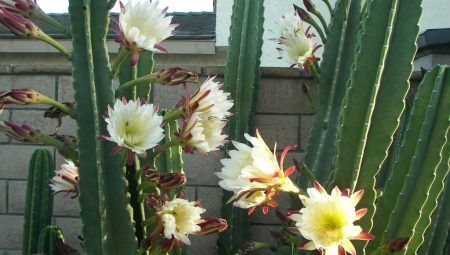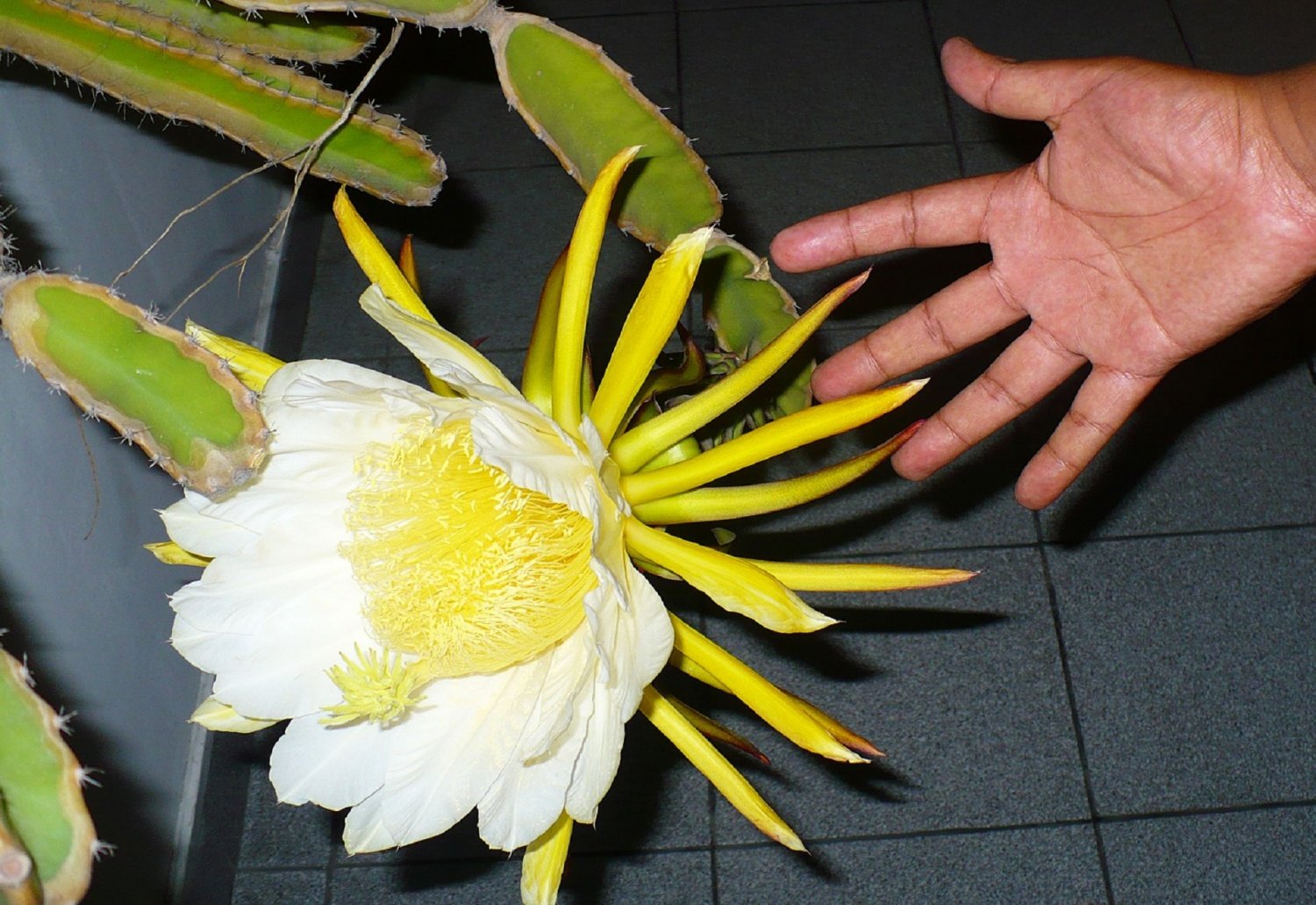Characteristic
Plants are sometimes confused with cacti from the genus Epiphyllum. The genus is known for its large, fragrant, night-blooming flowers, which are among the largest.
The stems of the "Queen of the Night" are curly or spreading, branched, sometimes they form tangles that release aerial roots, rigid, up to 10 m or more. The ribs are separated by wide, rounded intervals, and can be either slightly wavy or very bumpy.


The areola on the plant is small, there is a white or grayish-white pile, internodes 12-20 mm, thorns 5-18 mm. The needles are elliptical or round in cross section, yellowish-brown in color. White or brownish, ripe areoles usually do not have hairs; young plants have shorter and smaller thorns; the epidermis is bluish-green, often purple, smooth.
The inner tepals are 7.5-10 cm long, shorter than the outer ones, gradually narrowed. Stamens 38-50 mm long, delicate, white, anthers 1.5 mm long, yellowish.


From the unofficial name, it is easy to guess that the flower of this plant blooms at night, but pleases with its beauty only once. In diameter, they reach 30 centimeters, in terms of aroma they are somewhat reminiscent of vanilla.
They are pollinated by moths and less often by bats, as a result of which large fleshy fruits appear, which are prickly and acquire a red tint when fully ripe. Some species creep along the ground, while others cling to trees with aerial roots. Stems are ribbed, angled or flat, usually with short thorns.
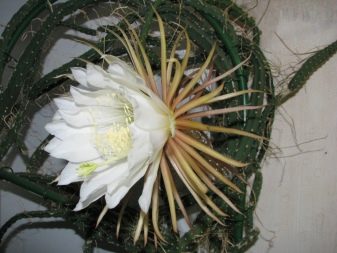
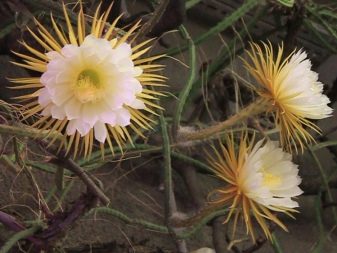
Reproduction and transplantation
Selenicereus is propagated by sowing seeds or rooting shoots. Seeds are harvested from ripe fruits and sown shortly. Seeds peeled from pulp should be dried in a cloth bag for several days. Prepare a flat pot with clay-sandy, moist soil. The seeds are deepened by 0.5-1 cm and covered with foil. The greenhouse is kept in a warm room (+ 20 ... + 25 ° C). Every day, the film is removed for 30 minutes and the soil is sprayed. The seeds germinate within 17-20 days. The shelter is removed and after 1-2 weeks young cacti are transplanted into separate pots.

In spring, you can cut cuttings from the tops of lashes 7-10 cm long. Places of cuts are sprinkled with crushed charcoal and dried in air for several hours. The stalk is buried in sandy-clay soil only a few millimeters and a support is created before rooting.
Since the cactus grows quickly, it needs a stable, voluminous pot. Large floor or table tubs will do. Young selenicereuses are transplanted annually, but gradually withstand an interval of 3-4 years. The soil for planting should include the following elements:
- sod soil;
- river sand;
- gravel.

You can use ready-made soil for cacti with gravel. Coarse drainage material is poured into the bottom of the pot. When transplanting, they try to remove as much of the old soil as possible. The surface of the soil must be loosened more often so that air flows to the root system.
Selenicereus - plant description
Selenicereus belongs to the Cactaceae family and has about 25 species. Its homeland is considered to be the tropical forested areas of South and Central America. The plant is also found on the rocks. Unlike most cacti, Selenicereus is an epiphyte - its long (up to 10-12 m) hanging shoots have aerial roots that cling to their forophytes. The diameter of the shoots is small - 1-3 cm, on their surface there are small and not too frequent thorns. The structure of the shoots is often ribbed, the color is green, sometimes with a bluish bloom.
During the flowering period, the cactus produces many short peduncles. Long buds in shape and color resemble candles. They ripen for 18-20 days. When opened, a large (up to 30 cm) flower of light shades and complex shape is formed. Its bloom lasts only a few hours, and by morning it fades.
The cactus got its name precisely because of such an unusual flowering. Selenicereus comes from the Latin words "selene" and "cereus", which means "goddess of the moon". Also, the flower is called "the queen of the night", "moon candle" or "snake cactus" for its long, creeping shoots.
Main types
Selenicereus grandiflorus

Despite the fact that flowering is quite spectacular in all species of this genus, only one of them is the most popular - Selenicereus large-flowered. It has very long climbing shoots. In the wild, these shoots often become tangled in thorny balls. Slightly wavy stems are quite thin, so their thickness is only 2.5 centimeters. On their faces, which are 7 or 8 pieces, there are small areoles with a whitish-gray edge. Each areola grows from 5 to 18 short spines, the length of which is 0.5-1.5 centimeters. As the stem matures, these thorns die off. The flowers of this cactus are very fragrant and their smell is similar to vanilla. The flower is very large, so, when opened, its diameter is 30 centimeters. The tube grows up to 22 centimeters long. In the perianth, the narrow-lanceolate outer lobes are pale brown, 7 to 10 centimeters long and 4.5 centimeters wide. The inner lobes broadly lanceolate with a narrow tip are slightly shorter than the outer ones. Of these, 2 or 3 not very dense loose layers are formed. In the core there are many yellowish stamens, the length of which is 5 centimeters. When flowering ends, purple egg-shaped fruits are formed. Their length, as a rule, does not exceed 8 centimeters.
This plant has a fairly long flowering. So, it can bloom throughout the summer period, even despite the fragility of the flower (it fades a few hours after opening). The fact is that during flowering, a cactus can set up to 50 buds.
Selenicereus anthonyanus

It is also a very spectacular type of Selenicereus, but it is not yet in great demand among domestic growers. This cactus is also popularly referred to as "fish bone". This climbing plant has flat, leafy and rather fleshy shoots, which are also very wide (up to 15 centimeters). A deeply dissected greenish-blue shoot is similar in shape to an oak or dandelion leaf, while its lobes are unpaired. Three short spines each protrude from comparatively small areoles. The diameter of the flower in the open state is 20 centimeters, and the length of the tube is 12 centimeters. The perianth has an unusual color of the lobes. So, the color smoothly changes from purple on the outside to creamy pink on the inside. The length and shape of these lobes are practically the same. The lobes of both the inner and outer parts are almost equal in width. Their length gradually increases from the center to the edges. There are a lot of them, so the space inside the flower is completely filled. Short yellowish stamens are almost invisible under a large pink-white pistil with a star-shaped stigma.
Selenicereus hook-shaped (Selenicereus hamatus)

This is also a very spectacular look, but it is very rare to find it in the collections of florists. The shoots are deep green in length and reach 12 meters in length, they have 4 or 5 ribs. On these ribs there are relatively large hooked spurs-processes, the length of which is 1 centimeter. 5 pieces of short (5 millimeters) spines protrude from the areoles, very similar to whitish-yellow stamens. Quite large flowers in the open state have a diameter equal to 20 centimeters, there is also a long tube - up to 40 centimeters. The rather wide lanceolate lobes of the perianth, located in the outer part, are painted in a light green color, and those that are inside are almost oval in shape.The lobes fit tightly enough to each other, while almost completely covering the neighboring ones. Due to this, they form a bowl shape. Light yellow long stamens are mixed with many long outgrowths of pistils (up to 18 pieces).
Selenicereus care
Caring for a cactus is simple, but even an unpretentious flower should at least be properly planted and watered regularly. Everything in order, let's start by compiling a suitable soil:
Soil for Selenicereus
First of all, take care of filling the pot with drainage. It can be pebbles or gravel. After that, it is necessary to mix several components that will give the plant maximum benefits.
Use turf, river sand, and the gravel already mentioned. To prevent root rot, add a little charcoal to the soil, which must first be crushed.
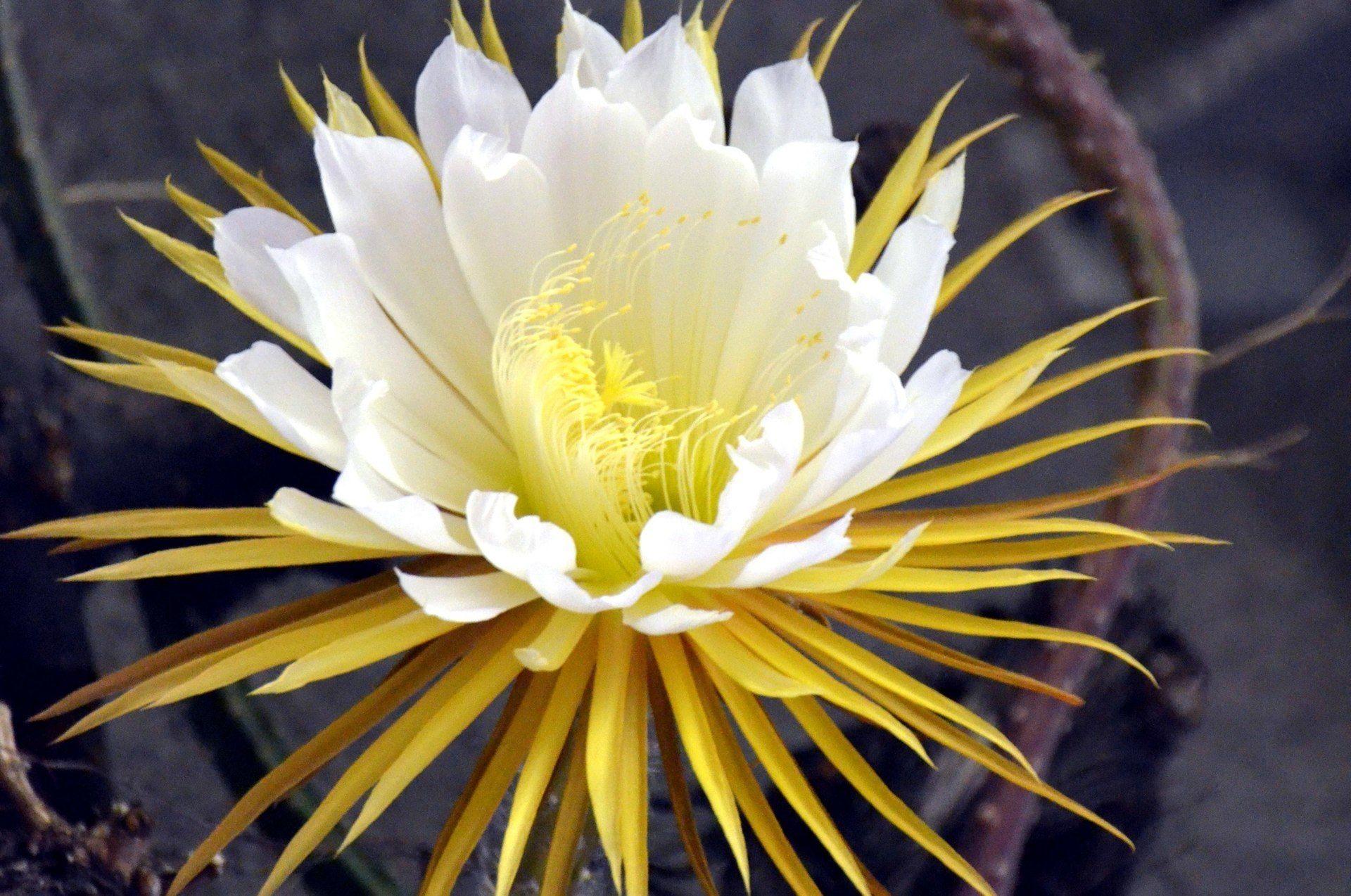
An inexperienced gardener can safely purchase ready-made soil, which already contains all the necessary components.
When choosing a flowerpot, be guided by its volume and stability. The pot must be large and stable, you can buy a floor planter that will fully satisfy all your needs.
Some flower owners choose a hanging planter, which helps to distribute the plant evenly throughout the room.
Lighting, watering rules
The cactus is not afraid of direct sunlight. You can place a young plant on a balcony or windowsill, the more light comes to the flower, the better and faster it will grow.
In summer, temperatures are not limited in any way, but in winter it is advisable to keep the thermometer at least 16 degrees above zero.
Watering should be irregular as the topsoil dries out. Make sure that moisture does not accumulate in the ground, otherwise the cactus promises decay and early death.

For irrigation, soft water purified from chlorine and other impurities is used. You can add a few drops of lemon juice, but don't get carried away as the acidic liquid can harm your cactus.
The taste of the water should remain the same, the temperature should be at room temperature. Humidification of a different type, such as a shower, spraying from a spray bottle, is rarely carried out.
Air humidity is not important for this plant, Selenicereus can get used to any circumstances.
Fertilizers, we form a plant
Top dressing will help with active growth, good fertilization will allow the flower to progress in a complex, without any pathologies. Use mineral fertilizers for cacti and succulents. These drugs are ideal for your selenicereus.
A long plant cannot be launched, otherwise, it will not work to disassemble a beautiful crown in chaos from dead and still growing shoots.
It is necessary to regularly prop up the crown, especially at a young age, but pruning the shoots should be done with great care. Sloppy movements will harm your plant, so be careful
You can refuse pinching, due to their uselessness.
Transfer
Since we touched on the importance of this aspect in the last section, let's describe in detail the process of moving a plant to a new location. A transplant is required for a young plant, an adult cactus is quite difficult to move, so it is recommended to simply change the soil in the flowerpot to a new one
A transplant is required for a young plant, an adult cactus is quite difficult to move, so it is recommended to simply change the soil in the flowerpot to a new one.

Make sure that the percentage of soil remaining is minimal, it is not known how the combination of new and old soil will end. However, there is nothing difficult in replacing the soil.
In another article, we described a plant called scindapsus.
Selenicereus disease
Selenicereus has only two scourges: mites and rot. The first can be overcome by detecting the spread of parasites in time and using appropriate chemicals.
The launched spider mite on Selenicereus attacks the plant everywhere, gnawing stems, affecting roots and flowers. As a result, Selenicereus dries up and loses its original appearance.
Improper watering of the cactus leads to the fact that the flower begins to rot. Problems like this are discovered during transplanting, and it is often too late to save the plant.

When transporting a cactus to a new location, pay attention to the density of the roots. Healthy roots are elastic, but soft and moist roots must be cut off immediately to protect healthy areas of the root system from disease.
If rot has begun to spread to the entire flowerpot, transplant the plant into new soil and correct the intensity of moisture.
In conclusion, I would like to wish you good luck in keeping such a beautiful plant as Selenicereus. Love your plant, and then it will reciprocate you. Good luck!
2.Acantoripsalis - home care
2.1 Temperature conditions
Optimal temperatures for acantoriapsalis during the day are 20 - 30 ° С, night temperatures are somewhat cooler, but not less than 10 ° С, especially in winter. Morozov does not tolerate.
2.2 Lighting
Direct sunlight in the morning and evening with shading on especially hot summer days, as burns may appear on the leaves of acantorisalis.
2.3 Care
Not demanding plant to care for. Damaged stems should be trimmed with a sharp, sterile knife. With adequate protection from rain and direct midday sun, acantoripsalis can be placed in a garden or balcony during the summer, however allow them to get used to the direct sun.
2.4 Substrate
The soil must be well-drained; a standard cactus mixture or a composition of clay granules, perlite, sphagnum and bark is suitable for growing acantoripsalis.
2.5 Top dressing
Fertilization is rarely necessary. Feed with cactus fertilizers in half concentration from April to September, once a month.
2.8 Air humidity
Use a room humidifier or place the pot on a pallet with damp pebbles to increase air humidity, possibly spraying.
2.9 Soil moisture
Give the acantoripsalis as much water as the earth can absorb. Any excess that seeps into the pallet should be removed after a few minutes. Standing water can lead to root rot. Let the top layer of the substrate dry before watering again.
2.11 Reproduction
Easily grown from cuttings. The cut site should be dried before planting for 2 - 3 days. Reproduction by seeds is a long process, in addition, caring for seedlings is rather difficult. Take apical cuttings and place them in ready-made cactus mix or wet sand. Rooting takes place within two to six weeks. Seeds can be sown in a greenhouse, in moist soil from sand and peat on depth 0.5 - 0.7 cm. Maintain even moisture until the plants germinate. Keep young plants in partial shade.
2.12 Pests and diseases
Decay when soil moisture is too high. Acantoripsalis does not bloom when there is a lack of light. When kept warm during the winter months, the shoots of the cactus stretch and become thin.
The main pests are mealybugs, spider mites and scale insects.
Insects are pests
| Insect name | Signs of infection | Control measures |
| Mealybug or felt insect | The surface of the leaves and shoots is covered with fluffy, cotton-like white bloom. Plants are lagging behind | Folk remedies: spraying with soap and alcohol solution. Infusion of tobacco, garlic, cyclamen tubers, alcohol treatments, pharmaceutical tincture of calendula proved to be good. Chemicals: green soap solution, Actellik, Fitoverm. |
| Spider mite | Subtle spider webs on the leaves, yellowing and foliage falling off with extensive lesions. The surface of the sheet plates becomes dead and covered with small cracks.Plant development slows down. | Folk ways. Plants can be rinsed in the shower and left in the bathroom in a humid atmosphere for half an hour. Irradiation with an ultraviolet lamp every week for 2 minutes. Chemical preparations based on pyrethrum, sulfur powders, Fitoverm, Actellik. |
| Shield and false shield | Sticky droplets on the leaves, small yellow spots on the surface of the leaf plates. With a large spread of scale insects, they contribute to the drying and falling of leaves. Flowers slow down their development | Folk methods of struggle. Spraying with soap and alcohol solution. Scabbard larvae do not like garlic infusion; they also use pyrethrum-based products. Chemicals. Fitoverm, Aktellik, Fufanon. |
-
Spider mite
-
Shield
-
Mealybug or felt insect
-
Mealybug
-
Shield
Note.
You may also be interested in:
Selenicereus blooms
Selenicereus (Selenicereus) is a cactus of tropical forests and the coast of Central and South America. It grows in forests, on the coast, on rocks and as an epiphyte in trees. It has hanging or creeping ribbed stems up to 2.5 cm thick. In nature, they are longer. Tough aerial roots hang from thin, thorny shoots. Selenicereus seems unattractive most of the time. Who likes a voluminous tangle of intertwined shoots with thorns? And where to find a place for him? In April, buds appear on the stems. At first, these are tiny fluffy balls, which gradually increase in size, and then form into large buds. Finally, just before sunset, a miracle occurs: a huge white flower with countless petals and golden sepals opens up. Its diameter is up to 35 cm! The room is filled with a vanilla-honey aroma. By morning, the flower fades.

"Queen of the night"
Pruning and shaping selenicereus
The formation of Selenicereus is by far the most difficult moment in their cultivation. Irregularly growing stems, sometimes densely branching, scattering in different directions, hanging, large, but at the same time, like all cacti, fearing injuries create problems with plant placement. Selenicereus requires constant formation and careful attention to tying. The work is always complicated by very tenacious, albeit small, rarely located thorns.
Supports are always installed for Selenicereus. Since the plant itself does not have an impressive appearance, it is precisely due to the supports that you can give it a great decorative effect. If you use regular pegs or boring supports, you can make the cactus even more unremarkable. In addition to tying to a support, Selenicereus will also need pruning of unattractive or long shoots. A full formation is not carried out, since it does not contribute to thickening or creating more beautiful bushes. Therefore, it is worth pruning only when the cactus really needs it (or it is advisable from the point of view of ease of handling the plant). Selenicereus grow back quite well after damage. But it is better to only cut no more than 3 shoots at a time, as more pruning will cause ugly stumps to form. If, during transplantation or other procedures, the shoots are accidentally injured, it is necessary to cut the stem as soon as possible just below the site of damage.

Views
"Cereus Peruvian" is also called "Rocky Cereus". The unusual name was obtained from the shape of the plant, which resembles a rock. The stem of this variety resembles a cylinder, and it is painted in a green-gray hue. Ribs are located on the surface of the stem. The height of the Peruvian cereus growing at home ranges from 50 to 100 centimeters.
This variety is also capable of fruiting, during which red or orange berries appear, even those allowed to be eaten. The Rocky Cereus requires quality lighting.During the warm season, it should be grown on a balcony or windowsill of a window facing south, and in winter, additional lighting should be installed. Special phytolamps will help to solve this problem.
"Cereus azure" in the wild reaches a height of 3 meters. The plant differs from other cacti by the presence of silvery-bluish shoots growing on the sides. On "Cereus" 6 or 7 ribs appear with light brown felt areoles and a wavy border. The spines reach one centimeter in length. They are located on the edges of the cactus, following radially. During flowering, large flowers appear, painted in a snow-white color. The length of the formation ranges from 20 to 25 centimeters, and the diameter ranges from 8 to 10 centimeters.
"Cereus validus", the second name of which sounds like "Cereus strong", has a height of about 2 meters in the wild. The bush usually has 5 to 8 shoots placed on the sides. The shoots are colored either light green or aquamarine. The number of ribs ranges from 4 to 8 pieces. Spines in the amount of 4 to 6 pieces grow on each rib. Their length reaches a couple of centimeters, and the color can be called a mixture of yellow and gray. During flowering, snow-white or even scarlet buds are formed on the cactus. Fruiting is realized in the form of reddish berries with white pulp.
"Spiral Cereus" is a perennial cactus, the thick stems of which have the shape of a ball, flat or embossed. The spines range in length from 2 to 3 centimeters, and the color is a mixture of brown and green. Flowering is carried out by the emergence of large buds, painted in pink-white color. "Cereus steel" has bluish shoots, placed on the sides of the plant and reaching 10 to 20 centimeters in diameter. Over time, the dimensions of these processes even increase.
The number of ribs ranges from 6 to 8 specimens. They are fairly straight with gray halos. The length of the spines ranges from 2 to 3 centimeters, and they are painted in a brown-gray shade. There are 20 of them. During the flowering period, one or a pair of huge buds appear, up to 30 centimeters. Flowers are painted in a mixture of white and green colors. The ten-centimeter berries, which are the result of fruiting, are colored in a coral shade.
"Giant Cereus" is often called the desert giant. It is even included in the Guinness Book of Records, as it has the highest height in the world, which is 25 meters. Over time, lateral processes are formed on the cactus, and the shape of the trunk changes. The plant bears fruit with bright red berries that can be eaten.
"Cereus monstrous" has lateral processes capable of growing together, as a result of which the shape of the plant changes. The fruits that "Monstroza" produces are edible, and the tall shrubs themselves are often used to create hedges.
Cereus Yamakaru has a traditional cylindrical stem covered with a large number of light spines. The buds open at night, reaching a diameter of 20 cm. The Uruguayan cereus is covered with sharp needles up to 2 centimeters long. The stem is aquamarine and covered with 5-8 ribs.
Other varieties of Cereus include Cereus Florida Peru and Cereus Paolina Peru. Cereus also include varieties such as Trichocereus, Chamecereus, Cephalocereus, Echinocereus and Pilosocereus. By the way, the care for all cacti of this variety is approximately the same.
7photos
Description of Selenicereus
The genus of this flower is attributed precisely to the Cactus, and it must be said that the plant is not devoid of characteristic features that all individuals of this common species have.
Selenicereus can be either an epiphyte, that is, a culture attached to a larger plant like a tree, or a terrestrial flower. Long shoots of a cactus can reach 12 meters, but the thickness of each of them will not exceed 3 centimeters.
Every year the plant grows by 2 meters, with simple calculations we find that the selenicereus adds 2-2.5 centimeters of net length per day. But, of course, such productivity is possible only with proper care and the right conditions, which the Selenicereus needs.

This cactus is known not only for its size, bright flowers that grow at the ends of the shoots also add characteristic features to the Selenicereus in appearance.
The crowns, which we have already talked about, reach as much as 30 centimeters in diameter, the colors are different, from pure white to a distinct pink. Such a beautiful picture can only be observed at night, hence the poetic name.
During the day, the plant rests, closing the buds, and making them look like a dense ball of multi-colored threads. The largest flowers are able to be replaced by fruits with juicy pulp, the fruits resemble an egg in shape, the average length is 8 centimeters.

The Selenicereus genus includes as many as 26 plants, many of which have remained wild, and, quite possibly, are not subject to domestication.
See also the article on the peresky cactus.
Selenicereus varieties
- Large-flowered Selenicereus is also called grandiflorus. Very long shoots are wrapped in a dense crust, which plays a protective role, preventing the stems from drying out. On the edges of the shoot, you can find needles, they are randomly located. Without the care and formation of a plant, grandiflorus is like a shapeless weave of vines, but by putting a cactus in order, you will get a beautiful courtyard culture. Flowers - one-day, or rather, "one-night". The buds bloom for only one night, but their number is so great that the whole bloom stretches for a whole month.
- Selenicereus Anthony. The flattened shoots curl interestingly in all directions, somewhat reminiscent of a fish skeleton. There are clusters of needles on the sides, but this does not spoil the plant. The large flowers are composed of a mass of narrow petals, each of which is colored bright purple or pale pink.
- Ms. McDonald's grade. Differences from grandiflorus consist only in brighter, characteristically orange, petals.
It is customary to choose from these types when you are looking for a home selenicereus for decorating a gazebo or winter garden, giving an interesting look to furniture.
Our following plant care guidelines are universal and will be great for the health of any variety of this cactus. But first, a few photos of the hero of our article:
Soil and fertilizer
 The soil for selenicereus should be medium-heavy, nutritious, but at the same time possess the qualities of good water and air permeability. Acidity can be neutral or slightly acidic.
The soil for selenicereus should be medium-heavy, nutritious, but at the same time possess the qualities of good water and air permeability. Acidity can be neutral or slightly acidic.
These cacti have thin and long stems that often branch out and produce many aerial roots.
This feature is associated with the way of life in nature, when a powerful root system helps them to firmly anchor on tree trunks or stones.
This property stimulates the constant formation of the stem with the help of props and tying, as well as frequent transplants, which are performed as the selenicereus grows.
To do this, prepare soil from the following components:
- sod land (2 parts);
- sheet land (1 part);
- coarse sand (1 part);
- perlite (1 part);
- expanded clay (part 1).
In this case, expanded clay is used as drainage, and perlite as an additional moisture regulator and baking powder.
Selenicereuses are fertilized once every three weeks. At the same time, complex mineral and liquid universal fertilizers alternate. The solution is made weakly concentrated and applied together with watering.
During the dormant period of Selenicereus, any feeding is stopped.
How Selenicereus reproduces
Breeding a plant involves the use of seed or cuttings. The first option is used less often due to the difficulty of buying seeds.
Germinating seeds
The procedure requires the purchase of ready-made Selenicereus seed from a flower shop. In the room, it almost never matures.
The seeds are immersed in a slightly moistened substrate at a shallow depth. After planting, the container is covered with plastic wrap or glass, kept in a room at a standard temperature regime. After the appearance of young shoots, the covering material is removed.
Rooting of shoots
Cutting is considered the best option for flower propagation. Long shoots are cut into small pieces, slightly dried and rooted in moist soil.
The box is covered with polyethylene or glass, regularly ventilated and watered. Spring is considered the best time for the procedure. For her, only young shoots are taken - in the old branches of Selenicereus, rooting is worse.
Important! Regardless of the method of reproduction, young growth is actively developing and gives an increase in shoots up to several meters annually. In the fifth year, the plant releases its first buds and begins to bloom.






